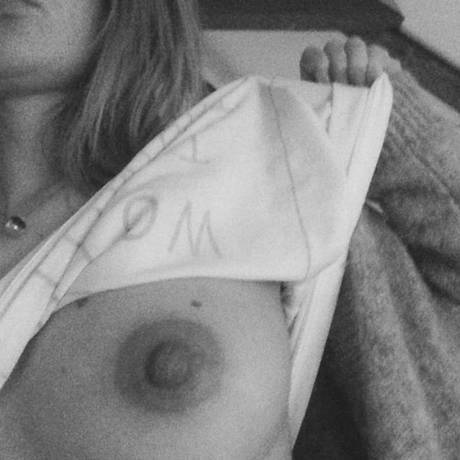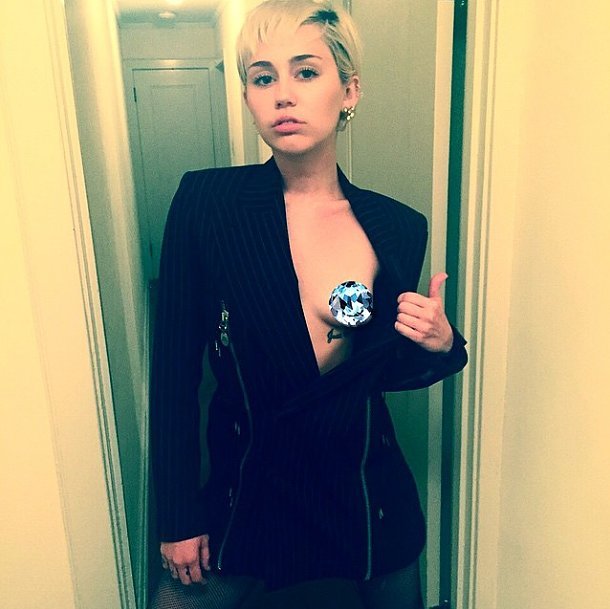Over the past several years, the fight to prove that women’s nipples are not the twin seats of all human shame has become the loudest, most popularly adopted (and Miley Cyrus and Liv Tyler and Scout Willis endorsed) movement in feminism. On Instagram, the hashtag now unites over 2 million images, and even Icelandic member of parliament Björt ?”lafsdóttir photographed herself with her shirt raised in solidarity earlier this year. The campaign is as important as the laws it contravenes are ridiculous. But is it also drowning out other calls for change, with less photogenic focal points, that would benefit women more? Topless feminism is not the only feminism.
freethenipple as a viral movement has done an amazing job of uniting women around the world. See this year’s topless Instagram takeover in Iceland, the three outspoken sisters who were arrested recently for cycling topless in Montreal, even the protesters in Hong Kong shouting that “breasts are not weapons.” And Miley Cyrus, again (yes, Miley!), in Marie Claire this month: “I’m not sure how titties are worse than guns.” But as Lina Esco, the movement’s founder, has argued from the beginning, we also need to use all the headlines about freed nipples as a platform to highlight other, graver inequalities. There is a danger that by focusing our own and the world’s gaze so intently on our breasts we fall into the trap of objectification and narrow-mindedness that the #freethenipple movement is trying to dismantle.
Esco, the director of the movie Free the Nipple (2014) started the #freethenipple campaign after it became nearly impossible for her to release the movie in 2013, due to its bare-chested female cast. It was a perfect illustration of the arbitrary censorship laws and societal prejudices about the female body that the movie critiqued. In three states in the US, women are still not legally allowed to walk down a street topless. Esco told Time, shortly before the film eventually came out with an NC-17 rating in December 2014: “Being topless is what we had to do start a real dialogue about equality. This is not about being topless; this about equality, it’s about having that choice.”
Her point is that the fight to liberate women’s nipples from nonsensical and discriminatory laws is part of a much larger war. If men can post topless photos of themselves on Instagram or sit shirtless in a park, women should not be censored or arrested for doing the same – not because being forced to keep our bras on during a hot day is the highest crime against womankind, but because it’s symptomatic of a deeper and more damaging sexism. A sexism that argues that women’s breasts are sexualized things that amount to public indecency if exposed and that inhibits women by inducing shame. It was exactly this culture of shame that brought together the group of women in 1969 that collectively drafted the landmark feminist classic Our Bodies, Ourselves (1971).
In the introduction, they wrote, “Our bodies are the physical bases from which we move out into the world; ignorance, uncertainty — even, at worst, shame — about our physical selves create in us an alienation from ourselves that keeps us from being the whole people that we could be.” Like Esco, they make the point that the struggle for women to claim equality starts with our bodies, but also that it doesn’t end there. It’s about moving out into the world.
The #freethenipple movement can sometimes lose sight of that. The feminist battleground is not limited to one small circle of skin.
Directly following that quote from Time, Esco goes on to say that, “A lot of people are not informed about the equal pay thing. Women still get paid 78 cents for every dollar a man makes, but very few people know about this. But if there’s a group of girls running around topless all over the United States rallying for equal pay, then it would be making headline news, don’t you think?”
There is an obvious correlation between nipple-baring protests and feminism’s increased coverage in the media recently. When i-D’s reporting of the Icelandic #freethenipple phenomenon went viral in March this year, 72% of the page views came from men. For a site with a roughly 60% female audience, that’s a big leap. And while you could attribute that to a generation of super conscious and enlightened male readers, the promise of seeing young Icelandic women’s boobs probably had a lot to do with it. Unwanted sexual attention is not an argument against the movement – one of its core missions is to desexualize breasts by making them more visible – but it does raise questions about means and ends, and who is truly controlling the conversation. As one writer asked in The Guardian in April, “Can a global movement that relies on photos of naked breasts really be one in the eye for patriarchy?”

At the other extreme, there is a growing movement of women who are reclaiming covering up their bodies as a feminist act. In June, British freelance writer Hanna Yusuf, spoke in a video about her decision to wear a hijab. “There’s nothing inherently liberating in covering up, just as there’s nothing inherently liberating in wearing next to nothing,” she says. “But the liberation lies in the choice” She warns against the “pseudo-feminist” assumption that all women who wear hijab are forced into it and oppressed.
In the US recently, journalist and media critic Jennifer Pozner wrote for the New York Times about her experience of being asked to appear in her underwear in a campaign for a women-run lingerie brand. She wasn’t asked to free her nipples, but she was asked to take off her clothes, allegedly in the name of female empowerment. It was also in the name of commercial gain, which complicates things. But her point about “stripping [women] of their expertise clothes,” still rings true. Disrobing professionally powerful women, as the brand had done for previous campaigns, was the opposite of empowering. “Googling by future employers would reveal the coders and CEOs in their skivvies before turning up their resumes,” Pozner wrote. The line between fighting objectification by removing our clothes and participating it is fine and not always clear. And in this case, as Pozner argued, the act of stripping down “promised no positive political impact.”
To honor and build on the progress the #freethenipple movement has already made — the Instagram account alone now has over 197 thousand supporters — we need to remember that, as Lina Esco says, this “movement [is] simply about freedom.” And freedom is not about reducing ourselves once again to just a pair of boobs. Taking it old-school, to quote Our Bodies, Ourselves, fighting for equality is about making ourselves “more self-confident, more autonomous, stronger and more whole.” Let’s not obsess over one part and forget the whole.
Credits
Text Alice Newell-Hanson
